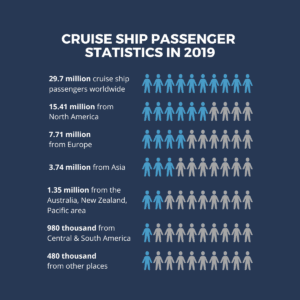Cruise ship holidays are very popular across the world, particularly in the United States. Every year, the Cruise Lines International Association (CLIA) releases an annual State of the Cruise Industry Outlook.
Cruise Ship Passenger Statistics
According to the CLIA, cruise holidays peaked in popularity in 2019, with 29.7 million cruise ship passengers worldwide. In comparison, only 17.9 million people took cruise ship holidays in 2009.
Out of these 29.7 million passengers, 15.41 million were from North America, accounting for almost 50% of all cruise ship passengers in 20197.71 million cruise ship passengers were from Europe, 3.74 million were from Asia, 1.35 million were from Australia/New Zealand/Pacific area, and only 980 thousand were from Central and South America. 480 thousand cruise ship passengers were from other places.

The most popular cruise ship destination was the Caribbean, including The Bahamas and Bermuda, with 11.98 million visitors. This is followed by Asia, including China, with 3.97 million visitors, and the Central and Western Mediterranean, with 3.211 million cruise ship tourists.
Cruise Ship Industry Economic Impact
In 2019, the cruise ship industry gave full-time employment to 1.16 million people worldwide, paying $50.53 billion in wages and salaries, and generating $154.5 billion in total output all over the world.
Additionally, it is calculated that each passenger in port spends an average of $385 before boarding a cruise, and around $100 when they visit a port during a cruise holiday.
There is also a burgeoning industry when it comes to booking a cruise holiday. The CLIA alone has 50 thousand travel agents worldwide, responsible for booking 75% of all cruise vacations. The association includes 13 thousand of travel agencies under its jurisdiction, such as large agencies, hosts, franchises, and consortia. The CLIA is made up of 57 cruise lines including ocean, river, and specialty cruise lines, representing over 95% of all cruise capacity worldwide. They work in association with 350 executive partners, from ports and destinations to suppliers and business services.
The Impact of COVID-19 on the Cruise Ship Industry
Unfortunately, the 2020 health contingency affected the cruise ship industry, as it did with most tourism worldwide. By mid-March 2020, CLIA members voluntarily halted all cruise passenger sailings worldwide, and repatriated over 100 thousand crew members, often by ship due to commercial air travel restrictions.
Between mid-March and September 2020, the CLIA estimates that the cruise ship industry lost over $77 billion in global economic activity, and half a million people employed in the industry lost their jobs.
Cruise ship tourism, to select destinations, resumed in July 2020, with over 200 sailings taking place during the second half of the year. The journeys took place following strict protocols, including 100% passenger and crew testing, masking and social distancing in shared areas, and stronger medical communication and pre-arranged response logistics.
Nevertheless, the cruise ship industry was optimistic about post-pandemic travel. Surveys reveal that 74% of cruise ship tourists planned to go back to cruise holidays within the next few years, and 2 out of 3 were willing to do so by 2021. In addition, 58% of surveyed people who had never traveled on a cruise were considering a cruise ship vacation in the near future. Of the 79 million international visitors who traveled to the United States in 2019, approximately 2.5 million came to embark on a cruise holiday and generated $4.5 billion in spending for the U.S. economy.
In summary, the cruise ship industry is an important part of global tourism. The majority of cruise ship travelers come from the U.S., and they primarily visit the Caribbean. Tourists are still interested in cruising around the world, including transatlantic and on-shore explorations. The cruise ship industry benefits not only the crew on board, but also the ports of origin and visiting destinations, as well as travel agents, cruise lines, and associated companies. Finally, despite the fact that the cruise ship industry has been affected by the COVID-19 pandemic, tourists are planning to take cruise ship vacations again or for the first time.
Source:
https://cruising.org/-/media/research-updates/research/2021-state-of-the-cruise-industry_opti mized.ashx